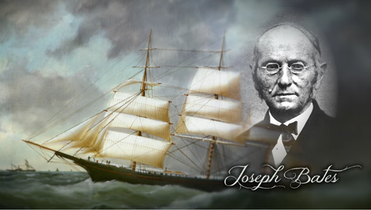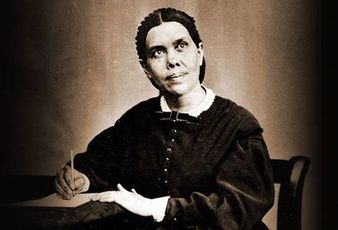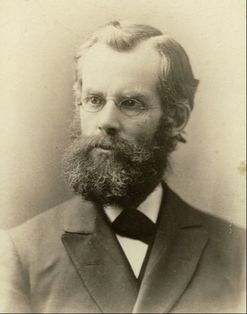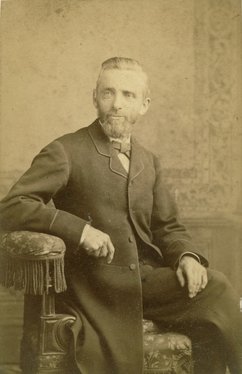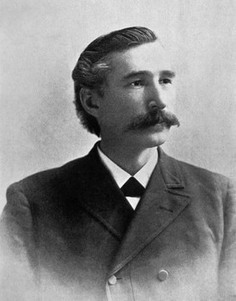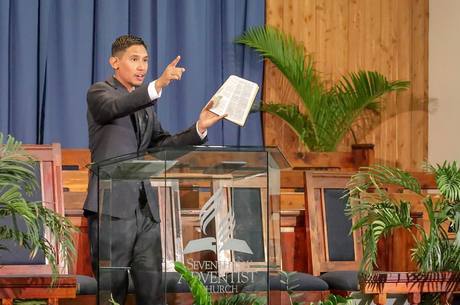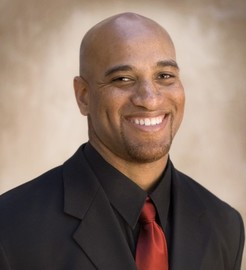VOICES OF THE PAST:
Joseph Bates
| |||
Joseph Bates (1792-1872)
At age 15, Joseph Bates “shipped” on a commercial vessel. For the next twenty-one years he lived the life of a sailor and ship captain. He returned to civilian life in 1828 with a small fortune. During the Advent Awakening, the retired sea captain became a respected evangelist and spiritual leader among the Adventists.
In early 1845, Bates was providentially led to an understanding of the truth concerning the seventh-day Sabbath, and in 1846 he published a 48-page tract on the subject. The respected Captain was the oldest member of our church pioneers, and he became the first Seventh-day Adventist local conference president (Michigan, 1861). He lived to the age of 80. One reason for his physical endurance, in spite of many sacrifices, was his simple diet and temperate habits. He organized of the first temperance societies in the United States. Bates was a spiritual man with clear-cut views and the courage of a lion. He did not hesitate to sacrifice when the need arose. Let us thank God for the venerable Captain — apostle of the Sabbath truth.
At age 15, Joseph Bates “shipped” on a commercial vessel. For the next twenty-one years he lived the life of a sailor and ship captain. He returned to civilian life in 1828 with a small fortune. During the Advent Awakening, the retired sea captain became a respected evangelist and spiritual leader among the Adventists.
In early 1845, Bates was providentially led to an understanding of the truth concerning the seventh-day Sabbath, and in 1846 he published a 48-page tract on the subject. The respected Captain was the oldest member of our church pioneers, and he became the first Seventh-day Adventist local conference president (Michigan, 1861). He lived to the age of 80. One reason for his physical endurance, in spite of many sacrifices, was his simple diet and temperate habits. He organized of the first temperance societies in the United States. Bates was a spiritual man with clear-cut views and the courage of a lion. He did not hesitate to sacrifice when the need arose. Let us thank God for the venerable Captain — apostle of the Sabbath truth.
Ellen G. White
Ellen G. White (1827-1915)
Ellen Harmon was born in Gorham, Maine. Ellen and her family first heard William Miller preach in 1840. She was converted at a Methodist camp meeting that same year, and was baptized two years later.
In December of 1844, Ellen received her first vision, regarding the travels of the advent people to the city of God. The Lord called her to a life-long ministry as His messenger. She met James White in February 1845, marrying him in August of 1846.
The early years of their marriage were marked with poverty, hard work, and poor health. In 1849 in response to a message from God through Ellen, James began a publishing work, beginning with the Present Truth.
In addition to personal messages given her for specific people, Mrs. White received visions and dreams outlining the Bible truths for our time. She wrote extensively on topics as varied as the great controversy between Christ and Satan, healthful living, proper methods of education, and godly family relations. Out of these messages, the believers were led to begin schools, sanitariums, and publishing houses.
She did the bulk of her writing during the last three decades of her life. During these years she labored particularly with others to bring the message of righteousness by faith in an end-time setting to the church, and then endeavored to contain the damage that ensued when this truth was rejected.
Mrs. White’s last years were spent living in California. Through times of apostasies and fires of judgment, the Lord continued to speak through her until the end, guiding, reproving, instructing the remnant church, ever pointing the sinner to Jesus and the cross, and sounding a clarion call to prepare to meet the Lord.
Ellen Harmon was born in Gorham, Maine. Ellen and her family first heard William Miller preach in 1840. She was converted at a Methodist camp meeting that same year, and was baptized two years later.
In December of 1844, Ellen received her first vision, regarding the travels of the advent people to the city of God. The Lord called her to a life-long ministry as His messenger. She met James White in February 1845, marrying him in August of 1846.
The early years of their marriage were marked with poverty, hard work, and poor health. In 1849 in response to a message from God through Ellen, James began a publishing work, beginning with the Present Truth.
In addition to personal messages given her for specific people, Mrs. White received visions and dreams outlining the Bible truths for our time. She wrote extensively on topics as varied as the great controversy between Christ and Satan, healthful living, proper methods of education, and godly family relations. Out of these messages, the believers were led to begin schools, sanitariums, and publishing houses.
She did the bulk of her writing during the last three decades of her life. During these years she labored particularly with others to bring the message of righteousness by faith in an end-time setting to the church, and then endeavored to contain the damage that ensued when this truth was rejected.
Mrs. White’s last years were spent living in California. Through times of apostasies and fires of judgment, the Lord continued to speak through her until the end, guiding, reproving, instructing the remnant church, ever pointing the sinner to Jesus and the cross, and sounding a clarion call to prepare to meet the Lord.
James White
| |||
James Springer White (1821-1881)
In his youth James White was a school teacher. He later became a Christian minister in Maine. He accepted William Miller’s views on the second advent and was successful in preaching the doctrine of the soon coming of the Savior.
He was a talented and capable executive, missionary leader, and powerful public evangelist. Not only did he participate with William Miller, Joseph Bates, and scores of other preachers in announcing the advent of our Lord near in the 1840’s, but he outlived the Millerite movement to become the first great apostle of the Seventh-day Adventist cause.
White was the publisher of the first periodical issued by Seventh-day Adventists, Present Truth (1849); the first editor of the Review and Herald (1850), the Youth’s Instructor (1852), also the Signs of the Times (1874). He was president of the General Conference between 1865-1867, 1869-1871, and 1874-1880.
If there was a founder of the Review and Herald Publishing Association, it was James White along with his wife, Ellen. He was the sponsor and promoter of the Pacific Press Publishing Association.
He died August 6, 1881, when he was only sixty. He literally worked himself to death. The brethren leaned on him so heavily that his towering figure fell. His sixty years of life were spent unselfishly and sacrificially. No other Seventh-day Adventist minister did more than he to build high principle and efficiency into the life of our churches and institutions.
In his youth James White was a school teacher. He later became a Christian minister in Maine. He accepted William Miller’s views on the second advent and was successful in preaching the doctrine of the soon coming of the Savior.
He was a talented and capable executive, missionary leader, and powerful public evangelist. Not only did he participate with William Miller, Joseph Bates, and scores of other preachers in announcing the advent of our Lord near in the 1840’s, but he outlived the Millerite movement to become the first great apostle of the Seventh-day Adventist cause.
White was the publisher of the first periodical issued by Seventh-day Adventists, Present Truth (1849); the first editor of the Review and Herald (1850), the Youth’s Instructor (1852), also the Signs of the Times (1874). He was president of the General Conference between 1865-1867, 1869-1871, and 1874-1880.
If there was a founder of the Review and Herald Publishing Association, it was James White along with his wife, Ellen. He was the sponsor and promoter of the Pacific Press Publishing Association.
He died August 6, 1881, when he was only sixty. He literally worked himself to death. The brethren leaned on him so heavily that his towering figure fell. His sixty years of life were spent unselfishly and sacrificially. No other Seventh-day Adventist minister did more than he to build high principle and efficiency into the life of our churches and institutions.
Uriah Smith
| |||
Uriah Smith (1832-1903)
In December 1852, Uriah Smith accepted the message taught by the Sabbath-keeping Adventist and soon was associated with the publishing interests of the believers in Rochester, New York. For about a half century he was the editor or on the editorial staff of the church paper, the Review and Herald. Smith was the first Secretary of the General Conference starting in 1863.
He is best known for his book, The Prophecies of Daniel and the Revelation. He was the first Bible teacher at Battle Creek College.
Elder Smith was often seen limping down the streets of Battle Creek with his cane and artificial limb, for he had suffered an amputation as a teenage boy.
W. A. Spicer gives us his impression of Uriah Smith: “As a boy I always passed Elder Smith’s editorial room in the old Battle Creek Review and Herald office with somewhat of awe: for there was a notice on the door in dark purple-colored ink and in large letters:
‘Editor’s Room.
Busy? Yes, always.
If you have any business,
Attend to your business,
And let us attend to our business.'”
Smith was a man who was on the march. Though he was busy with the Lord’s business and he wanted others to be about theirs, he was a gracious and tender-hearted man.
In December 1852, Uriah Smith accepted the message taught by the Sabbath-keeping Adventist and soon was associated with the publishing interests of the believers in Rochester, New York. For about a half century he was the editor or on the editorial staff of the church paper, the Review and Herald. Smith was the first Secretary of the General Conference starting in 1863.
He is best known for his book, The Prophecies of Daniel and the Revelation. He was the first Bible teacher at Battle Creek College.
Elder Smith was often seen limping down the streets of Battle Creek with his cane and artificial limb, for he had suffered an amputation as a teenage boy.
W. A. Spicer gives us his impression of Uriah Smith: “As a boy I always passed Elder Smith’s editorial room in the old Battle Creek Review and Herald office with somewhat of awe: for there was a notice on the door in dark purple-colored ink and in large letters:
‘Editor’s Room.
Busy? Yes, always.
If you have any business,
Attend to your business,
And let us attend to our business.'”
Smith was a man who was on the march. Though he was busy with the Lord’s business and he wanted others to be about theirs, he was a gracious and tender-hearted man.
J. N. Andrews
| |||
John Nevins Andrews (1829-1883)
J. N. Andrews was an intellectual who enjoyed “severe study” much more than physical activity. He was closely associated with James & Ellen White in the leadership and evangelistic work of the SDA Church.
As a theologian, Andrews made great strides in the development of church doctrines. He applied the two-horned beast of Rev. 13 to the United States of America. Further, he was influential in creating the church’s bylaws and constitution. In 1855, after thorough investigation, Andrews adopted sunset Friday evening as the beginning of the Sabbath. This began a standard for the church. He also organized the church as a legal business association, allowing the church to obtain legal possession of property. During the Civil War, Andrews lobbied for non-combatant designation for SDA draftees.
In 1860, he was involved in the organization of the denominational publishing house. The following year, he published his extensive research, History of the Sabbath & the First Day of the Week. This was a work reviewing the seventh-day Sabbath in history. Between 1869-70, he was the editor of the Review and Herald.
In 1874, he became the first SDA missionary in Switzerland. He worked to gather the scattered Sabbath-keeping companies and organize them with a united message. While living in Basel, he contracted tuberculosis and died. He was 54.
J. N. Andrews was an intellectual who enjoyed “severe study” much more than physical activity. He was closely associated with James & Ellen White in the leadership and evangelistic work of the SDA Church.
As a theologian, Andrews made great strides in the development of church doctrines. He applied the two-horned beast of Rev. 13 to the United States of America. Further, he was influential in creating the church’s bylaws and constitution. In 1855, after thorough investigation, Andrews adopted sunset Friday evening as the beginning of the Sabbath. This began a standard for the church. He also organized the church as a legal business association, allowing the church to obtain legal possession of property. During the Civil War, Andrews lobbied for non-combatant designation for SDA draftees.
In 1860, he was involved in the organization of the denominational publishing house. The following year, he published his extensive research, History of the Sabbath & the First Day of the Week. This was a work reviewing the seventh-day Sabbath in history. Between 1869-70, he was the editor of the Review and Herald.
In 1874, he became the first SDA missionary in Switzerland. He worked to gather the scattered Sabbath-keeping companies and organize them with a united message. While living in Basel, he contracted tuberculosis and died. He was 54.
J. N. Loughborough
| |||||||
John Norton Loughborough (1832-1924)
J. N. Loughborough became a Sabbath-keeping Adventist through the labors of J. N. Andrews. He began preaching immediately and was ordained in 1854. He, along with D. T. Bordeau, were our first missionaries, sent to California in 1868. In 1878, he was sent to Europe. He was at one time president of the Illinois Conference. He was the denomination’s first historian, and wrote the books, The Rise and Progress of Seventh-day Adventists and The Great Second Advent Movement.
Like most of the early Advent leaders, Loughborough took a real interest in the literature work. He and James White discussed ways and means of advancing the work of the gospel. It was suggested that if books were offered to the public in connection with preaching services, the people would be willing to pay a small price for them. Thus, the way would be prepared for more literature to be produced. Young Loughborough tried this method, and it was a success.
Loughborough was truly a great pioneer, lending his many talents to the development of the work wherever there was a need.
Elder Loughborough was obedient to the heavenly vision, and God used him in a mighty way to build up the interest of His cause. Loughborough spent his last years in the St. Helena Sanitarium, where he passed away peacefully on April 7, 1924, at the ripe old age of ninety-two.
J. N. Loughborough became a Sabbath-keeping Adventist through the labors of J. N. Andrews. He began preaching immediately and was ordained in 1854. He, along with D. T. Bordeau, were our first missionaries, sent to California in 1868. In 1878, he was sent to Europe. He was at one time president of the Illinois Conference. He was the denomination’s first historian, and wrote the books, The Rise and Progress of Seventh-day Adventists and The Great Second Advent Movement.
Like most of the early Advent leaders, Loughborough took a real interest in the literature work. He and James White discussed ways and means of advancing the work of the gospel. It was suggested that if books were offered to the public in connection with preaching services, the people would be willing to pay a small price for them. Thus, the way would be prepared for more literature to be produced. Young Loughborough tried this method, and it was a success.
Loughborough was truly a great pioneer, lending his many talents to the development of the work wherever there was a need.
Elder Loughborough was obedient to the heavenly vision, and God used him in a mighty way to build up the interest of His cause. Loughborough spent his last years in the St. Helena Sanitarium, where he passed away peacefully on April 7, 1924, at the ripe old age of ninety-two.
A. T. Jones
| |||
Alonzo T. Jones (1850-1923)
At age 20, A. T. Jones began three years of service in the Army. Interestingly enough, he spent much of his time pouring over large historical works, SDA publications, and the Bible. He was baptized when he left the Army, and began preaching on the West Coast. In May, 1885, he became editor of the Signs of the Times, and was later joined by E. J. Waggoner.
In 1888, these two men stirred the General Conference session in Minneapolis with their preaching on righteousness by faith. For several years thereafter, they preached on that subject from coast to coast. Ellen White accompanied them on many occasions. She saw in Jones’ presentations of “the precious subject of faith and the righteousness of Christ…a flood of light” (EGW 1888 Materials, p. 291).
Jones was on the General Conference Committee in 1897 and editor-in-chief of the Review and Herald from 1897 to 1901.
In 1889, with J. O. Corliss, he spoke against a bill in the U.S. Congress on Sunday observance; the bill was defeated. Thereafter he was a prominent speaker for religious freedom, serving as editor of the forerunner of the Liberty magazine.
After being president of the California Conference (1901-1903), he joined Dr. J. H. Kellogg’s staff against the counsel of E. G. White, a move which after a series of unfortunate misunderstandings and unwise choices, led to his separation from denominational employment and loss of church membership.
Jones remained a Sabbath observer and loyal to most of the other doctrines of the church. He is remembered especially for his part in bringing into prominence the doctrine of justification by faith.
At age 20, A. T. Jones began three years of service in the Army. Interestingly enough, he spent much of his time pouring over large historical works, SDA publications, and the Bible. He was baptized when he left the Army, and began preaching on the West Coast. In May, 1885, he became editor of the Signs of the Times, and was later joined by E. J. Waggoner.
In 1888, these two men stirred the General Conference session in Minneapolis with their preaching on righteousness by faith. For several years thereafter, they preached on that subject from coast to coast. Ellen White accompanied them on many occasions. She saw in Jones’ presentations of “the precious subject of faith and the righteousness of Christ…a flood of light” (EGW 1888 Materials, p. 291).
Jones was on the General Conference Committee in 1897 and editor-in-chief of the Review and Herald from 1897 to 1901.
In 1889, with J. O. Corliss, he spoke against a bill in the U.S. Congress on Sunday observance; the bill was defeated. Thereafter he was a prominent speaker for religious freedom, serving as editor of the forerunner of the Liberty magazine.
After being president of the California Conference (1901-1903), he joined Dr. J. H. Kellogg’s staff against the counsel of E. G. White, a move which after a series of unfortunate misunderstandings and unwise choices, led to his separation from denominational employment and loss of church membership.
Jones remained a Sabbath observer and loyal to most of the other doctrines of the church. He is remembered especially for his part in bringing into prominence the doctrine of justification by faith.
E. J. Waggoner
| |||||||
Dr. Ellet J. Waggoner (1855-1916)
In 1884 E. J. Waggoner became assistant editor of the Signs of the Times, under his father, J. H. Waggoner. Two years later, he and A. T. Jones became editors of the same journal, Waggoner remaining in the position until 1891.
At the 1888 General Conference session in Minneapolis, Minnesota, he and Jones gave their famous series of sermons on righteousness by faith.
In 1892 he became editor of the Present Truth, in England, where he lived until 1902. While there he conducted, with W. W. Prescott, a workers’ training school and, for a short time, was president of the South England Conference.
After returning to the United States, he worked briefly on the staff of Emmanuel Missionary College.
Domestic difficulties led to divorce and remarriage, resulting in his becoming separated from denominational employment. Some used this as a springboard to discredit his positive testimony on righteousness by faith, as Mrs. White once warned might happen if he were overthrown by the temptations of the enemy.
Regardless of what happened to the man, Mrs. White declared about the message, “I see the beauty of truth in the presentation of the righteousness of Christ in relation to the law as the doctor has placed it before us.” MS 15, 1888. She also said, “When the Lord had given to my brethren the burden to proclaim this message, I felt inexpressively grateful to God, for I know it was the message for this time.” MS. 24, 1888.
In 1884 E. J. Waggoner became assistant editor of the Signs of the Times, under his father, J. H. Waggoner. Two years later, he and A. T. Jones became editors of the same journal, Waggoner remaining in the position until 1891.
At the 1888 General Conference session in Minneapolis, Minnesota, he and Jones gave their famous series of sermons on righteousness by faith.
In 1892 he became editor of the Present Truth, in England, where he lived until 1902. While there he conducted, with W. W. Prescott, a workers’ training school and, for a short time, was president of the South England Conference.
After returning to the United States, he worked briefly on the staff of Emmanuel Missionary College.
Domestic difficulties led to divorce and remarriage, resulting in his becoming separated from denominational employment. Some used this as a springboard to discredit his positive testimony on righteousness by faith, as Mrs. White once warned might happen if he were overthrown by the temptations of the enemy.
Regardless of what happened to the man, Mrs. White declared about the message, “I see the beauty of truth in the presentation of the righteousness of Christ in relation to the law as the doctor has placed it before us.” MS 15, 1888. She also said, “When the Lord had given to my brethren the burden to proclaim this message, I felt inexpressively grateful to God, for I know it was the message for this time.” MS. 24, 1888.
C. D. Brooks
Charles Decatur (C.D.) Brooks (1930-2016)
Charles Decatur (C.D.) Brooks, field secretary for the Seventh-day Adventist World Church, was born in Greensboro, North Carolina, on July 24, 1930, the tenth child of Marvin and Mattie Brooks. Brooks was raised on a 40-acre farm outside of Greensboro where his Methodist family grew a variety of produce and raised livestock and poultry. In 1940 Brooks, along with his mother and six sisters, was baptized into the Seventh-day Adventist Church. At age sixteen, he felt the call to enter the gospel ministry.
Brooks studied theology at Oakwood College (now Oakwood University) from 1947 to 1951. During his collegiate years, he edited Oakwood’s yearbook. At Oakwood, Brooks also met Walterene Wagner, whom he married on September 14, 1952. They had a daughter, Deidre, and son, Charles Jr.
Brooks, a prolific evangelist, was a pastor of several churches in Pennsylvania, New Jersey, and Ohio, from 1951 to 1963. From 1963 to 1971, he was the field secretary and ministerial secretary for the Columbia Union (an organizational unit of the Adventist church covering the Mid-Atlantic States). In this capacity, he toured the eastern United States preaching, training ministers, evangelizing, and notably, breaking down longstanding racial barriers that had persisted in the church.
In 1971 Brooks became one of seven general field secretaries for the Seventh-day Adventist World Church. As field secretary, he represented the church around the globe, preaching and conducting evangelistic campaigns on six continents. Listeners of all races, nationalities, ages, and backgrounds were captivated by Brooks’s powerful, riveting, and eloquent sermons, and cassette tapes of his messages were reproduced by the thousands.
In 1974 Brooks became speaker-director of Breath of Life Ministries, a Christian-themed telecast that was the first continuously-running black religious television programming. Along with TV and radio broadcasts, Breath of Life Ministries conducted successful evangelistic campaigns in dozens of U.S. and international cities. In 1989 Breath of Life began airing on Black Entertainment Television (BET), potentially reaching ninety million people per week.
Brooks was speaker-director of Breath of Life Ministries from 1974 to 1997, and during his time at the helm, the ministry brought approximately twenty thousand people to the Christian faith, established fifteen Breath of Life congregations, and was viewed by millions. Significantly, he was a leading evangelist in the era when an unprecedented number of accessions contributed to the demographic shift of Protestant Christianity to the global South.
Brooks spoke at President Ronald Reagan’s religious inaugural celebration in 1981, received an honorary doctorate from Andrews University in 1985, and in 1994 was inducted into the Martin Luther King Jr. Board of Preachers and Collegium of Scholars at Morehouse College. In 1995 Brooks participated in Net ’95, the largest and most extensive evangelistic program in Seventh-day Adventist history up to that time.
After suffering a heart attack in June 1995, Brooks the following year retired as field secretary. He retired as speaker-director for Breath of Life in the spring of 1997.
Brooks had a productive retirement. In 2007 the Bradford-Cleveland-Brooks Leadership Center was established on the campus of Oakwood University in a 10,000-square-foot, $2.5 million state-of-the-art edifice. In 2013 he was appointed chaplain of the North American Division of Seventh-day Adventists. During this time, Brooks’s preaching gained new life on social media and video and audio-sharing sites on the Internet.
In early 2016, C.D. Brooks was diagnosed with pancreatic cancer. He died on June 5, 2016, in Laurel, Maryland, leaving behind Walterene, his wife of sixty-three years.
Charles Decatur (C.D.) Brooks, field secretary for the Seventh-day Adventist World Church, was born in Greensboro, North Carolina, on July 24, 1930, the tenth child of Marvin and Mattie Brooks. Brooks was raised on a 40-acre farm outside of Greensboro where his Methodist family grew a variety of produce and raised livestock and poultry. In 1940 Brooks, along with his mother and six sisters, was baptized into the Seventh-day Adventist Church. At age sixteen, he felt the call to enter the gospel ministry.
Brooks studied theology at Oakwood College (now Oakwood University) from 1947 to 1951. During his collegiate years, he edited Oakwood’s yearbook. At Oakwood, Brooks also met Walterene Wagner, whom he married on September 14, 1952. They had a daughter, Deidre, and son, Charles Jr.
Brooks, a prolific evangelist, was a pastor of several churches in Pennsylvania, New Jersey, and Ohio, from 1951 to 1963. From 1963 to 1971, he was the field secretary and ministerial secretary for the Columbia Union (an organizational unit of the Adventist church covering the Mid-Atlantic States). In this capacity, he toured the eastern United States preaching, training ministers, evangelizing, and notably, breaking down longstanding racial barriers that had persisted in the church.
In 1971 Brooks became one of seven general field secretaries for the Seventh-day Adventist World Church. As field secretary, he represented the church around the globe, preaching and conducting evangelistic campaigns on six continents. Listeners of all races, nationalities, ages, and backgrounds were captivated by Brooks’s powerful, riveting, and eloquent sermons, and cassette tapes of his messages were reproduced by the thousands.
In 1974 Brooks became speaker-director of Breath of Life Ministries, a Christian-themed telecast that was the first continuously-running black religious television programming. Along with TV and radio broadcasts, Breath of Life Ministries conducted successful evangelistic campaigns in dozens of U.S. and international cities. In 1989 Breath of Life began airing on Black Entertainment Television (BET), potentially reaching ninety million people per week.
Brooks was speaker-director of Breath of Life Ministries from 1974 to 1997, and during his time at the helm, the ministry brought approximately twenty thousand people to the Christian faith, established fifteen Breath of Life congregations, and was viewed by millions. Significantly, he was a leading evangelist in the era when an unprecedented number of accessions contributed to the demographic shift of Protestant Christianity to the global South.
Brooks spoke at President Ronald Reagan’s religious inaugural celebration in 1981, received an honorary doctorate from Andrews University in 1985, and in 1994 was inducted into the Martin Luther King Jr. Board of Preachers and Collegium of Scholars at Morehouse College. In 1995 Brooks participated in Net ’95, the largest and most extensive evangelistic program in Seventh-day Adventist history up to that time.
After suffering a heart attack in June 1995, Brooks the following year retired as field secretary. He retired as speaker-director for Breath of Life in the spring of 1997.
Brooks had a productive retirement. In 2007 the Bradford-Cleveland-Brooks Leadership Center was established on the campus of Oakwood University in a 10,000-square-foot, $2.5 million state-of-the-art edifice. In 2013 he was appointed chaplain of the North American Division of Seventh-day Adventists. During this time, Brooks’s preaching gained new life on social media and video and audio-sharing sites on the Internet.
In early 2016, C.D. Brooks was diagnosed with pancreatic cancer. He died on June 5, 2016, in Laurel, Maryland, leaving behind Walterene, his wife of sixty-three years.

